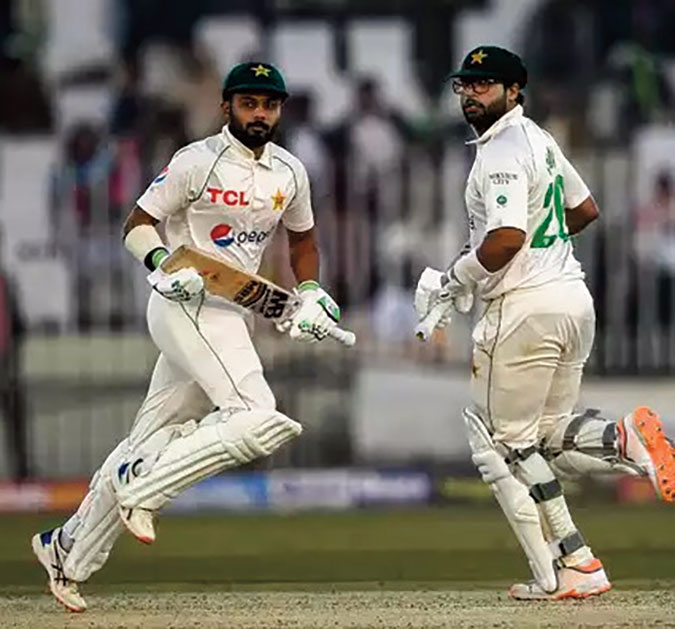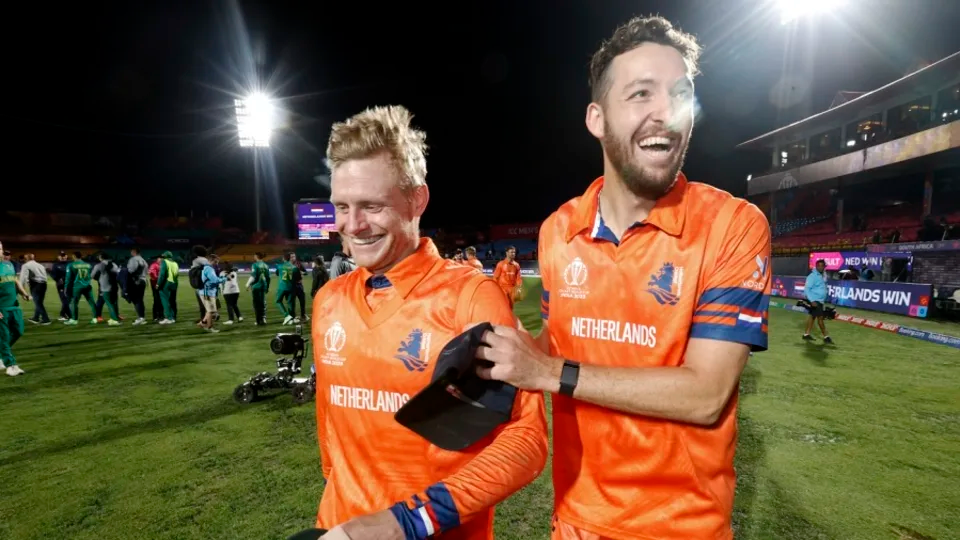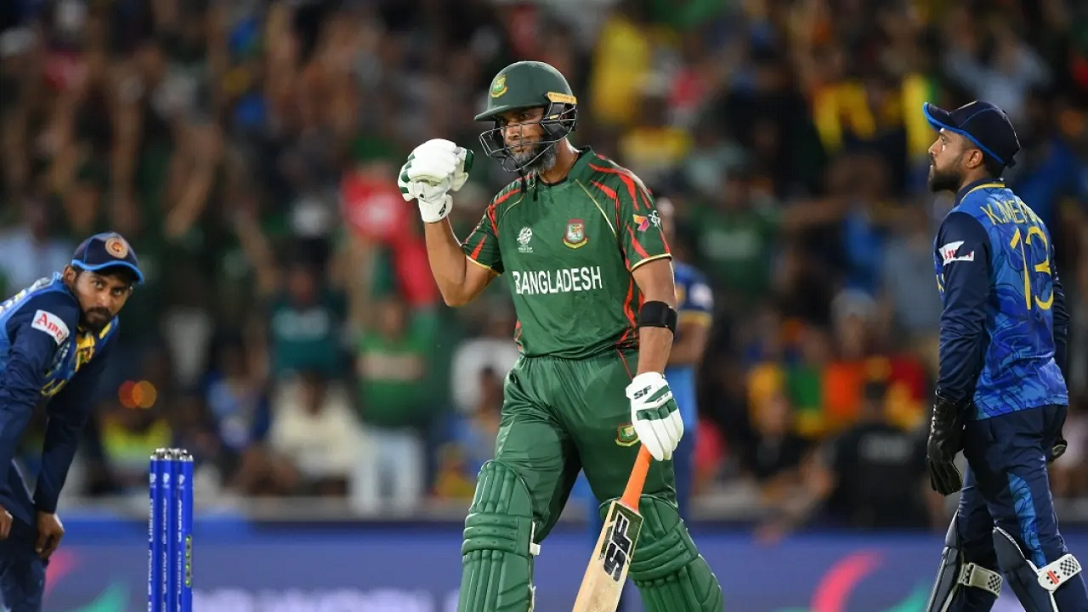Sports
England declaration sets up intriguing final day in Rawalpindi

Brendon McCullum and Ben Stokes had underscored their philosophy several times over: England will risk defeat in order to win Test matches. And so it proved in Rawalpindi. The visitors offered a brave declaration of their second innings, asking Pakistan to chase 342 for victory with about 100 overs left in the game, light permitting. At the end of another truncated final session, Pakistan had whittled down 80 runs from their target but lost two of their first-innings centurions Abdullah Shafique and Babar Azam along the way while experienced batter Azhar Ali had to retire hurt with a finger injury.
Thankfully for the hosts, their other centurion from the first dig, Imam-ul-Haq, survived England’s bouncer plan and moved along to 43 and added 55 runs for the third wicket in the company of Saud Shakeel. It was a tricky 20 over period for Pakistan before bad light ended play early once more. They were chasing leather for much of the day before Stokes and McCullum dangled the fourth-innings carrot. Given the pitch had continued to remain benign deep into the fourth day, a chase at a rate above three runs to the over wasn’t going to be difficult. But, in it was England’s best chance to force mistakes out of their excitable opponents.
Stokes also began the final session by inverting all usual conventions. Test cricket’s most prolific fast bowler, James Anderson, was not handed the new ball and instead Ollie Robinson and Stokes took it upon themselves to test out areas half-way down from the batters. The bouncer ploy worked. Shafique miscued a pull and was caught by Harry Brook at deep square leg. Ollie Robinson then around the stumps and got a ball to climb awkwardly on Azhar Ali and pinged him on the fingers, forcing the senior batter into retiring hurt. In walked Babar at No.4. He slapped one short ball over the off-side for four but then was caught in two minds against a Stokes short ball and inside-edged a ball to the ‘keeper.
At 25/2, Pakistan were wobbling. But the pair of Imam and Shakeel managed to work their way out of trouble. It helped that the ring of attacking fielders stationed by Stokes allowed for ready boundary opportunities. Jack Leach, for instance, when introduced into the attack bowled with a pair of catching mid-wickets, a slip, a forward short leg and a silly point. That meant Shakeel could simply chip the ball towards mid-on for a pair of boundaries. There was one nervy moment for Pakistan when a Shakeel clip went straight to Keaton Jennings at short leg but the reflex catch didn’t ‘stick’ and Pakistan could go into the final day with no further damage and still with a realistic chance of victory.
It is an intriguing place for them to find themselves having conceded 657 in the first innings and then again 264 in less than 36 overs on the fourth day. When it was their turn to bat, England’s batters were in no mood to allow the game to peter out. Zak Crawley, Joe Root and Harry Brook all hit fifties at faster than a run a ball.
The signs were not hard to read in that second session. Crawley, who was on 24 at Lunch, began with an on-drive and a square drive while Root played an audacious reverse scoop off Naseem Shah for a boundary of his own. Almost immediately after getting to a half-century to go with his first-innings ton, Crawley was strangled down the legside attempting to put away a short ball from Mohammad Ali. The umpires didn’t pick up the glove and the opener himself appeared to suggest the ball had hit his shoulder but Pakistan’s ring fielders were convinced enough to ask for the DRS aid and get their third wicket.
Brook joined Root with the former captain seamlessly taking over as the tempo setter. He continued to play with the field, pushing the ball into gaps and running twos or using his famous dab to run the ball down to third man. Despite hitting only four boundaries, Root had a 48-ball 50 of his own.
Babar Azam, already hamstrung by the loss of Haris Rauf to an injury, brought the spinners on with the strategy to bowl from round the stumps and into the right-handers’ blindspot. To counter and continue with his run-making ways, Root turned into a left-hander for a ball and then abandoned that move in favour of the reverse sweep. Boundaries continued to flow as Root raced into the 70s. Eventually, Zahid Mahmood and Pakistan’s persistence paid off when Root eventually miscued a sweep and was caught at short fine. Ben Stokes followed his former skipper into the dressing room in the same over, miscuing a shot to sweeper cover.
Brook took over from there and launched an all-out offense on debutant legspinner Mahmood, repeatedly slogging him over mid-wicket or stepping out and hitting him over his head. Will Jacks, promoted above the injured Liam Livingstone, hit three sixes off his own in a 13-ball knock of 24. It was Brooks, however, who was marched on rapidly towards a second hundred of the game before he was out on the cusp of the Tea break, bowled off Naseem Shah while trying to swipe across the line. His 11 fours and three sixes, however, was perfect for England to set up a brave declaration.
More earlier in the day, Jacks finished with a six-fer on debut, having known of his participation in the Test merely minutes before the start of the game. Pakistan had begun the day, trailing England by 158 in the first innings and had Agha Salman to thank for eating into his deficit by farming the strike with the tail. Salman though edged Jacks to first slip and the offie went on to dismiss Mahmood and Rauf for figures of 6 for 161. Little would he have known then that he would be needed to produce another strong show on the final day for that first-innings performance to not end up on a losing side.
Brief scores:
England 657 and 264 for 7 decl. (Harry Brook 87, Joe Root 73; Mohammad Ali 2-64)
Pakistan 579 and 80/2 (Imam-ul-Haq 43n.o.)
Sports
England face Australia in the battle of champions

The first truly heavyweight clash of this expanded T20 World Cup format comes freighted with both history and subplots. A rematch of the 2010 World T20 final at Kensington Oval, the match pits Jos Buttler’s defending champions – who are aiming to become the first team to retain the trophy – against the Australian winning machine, victors at the 2021 edition and current world title-holders in Test and ODI cricket. And that’s before you throw in the Ashes for afters.
Already there is added pressure on England, after the rain in Bridgetown led to a share of the points in their opener against Scotland (and that having conceded 90 runs from 10 overs without taking a wicket in a tepid bowling display). Lose to their oldest rivals and it will leave their Super 8 prospects open to being waylaid by the perils of net run-rate calculations, or worse.
The Scotland match was the third abandonment in five suffered by England, after a rain-affected home series against Pakistan, which has clearly hampered their readiness for this campaign after almost six months without playing T20 together. It does not take much for a side to click in this format – and England looked in decent shape when they did get on the field against Pakistan – but Buttler will be anxious for things to go their way on Saturday, if only to avoid further questions referencing the team’s disastrous ODI World Cup defence last year.
Australia, under the laidback leadership of Mitchell Marsh would love nothing more than to add to the English sense of jeopardy – having helped bundle them out of the tournament in India on the way to taking the crown. Their head to head record is less impressive in T20 however, with England having won six of the last seven completed encounters, as well as that 2010 final.
Despite a wobble with the bat, Australia avoided mishap against Oman earlier in the week, the experience of David Warner and Marcus Stoinis shining through in difficult batting conditions. Surfaces in the Caribbean – not to mention those games staged in the USA – have already had teams scratching their heads; rather than the “slug-fest” England had prepared for, following a high-scoring tour of the Caribbean in December, it looks as if boxing smart may be the way to go.
Speaking of Warner, this could be the last time he faces up against England in national colours – and another match-winning contribution would likely reduce the chances of them meeting again in the knockouts. On the other side of the card is Jofra Archer, fresh from an emotional maiden outing at Kensington Oval and ready to take on Australia for the first time in any format since 2020. Can Mark Wood fire up England’s campaign, as he did during last summer’s Ashes? Will Pat Cummins be back to harass the old enemy once again? Seconds out, it’s almost time to rumble.
Cummins is set to return after being rested for the Oman game, which saw Mitchell Starc leave the field with cramp. Starc is understood to be fine and could keep his place – which would likely see Nathan Ellis miss out. Marsh is still not fit to bowl, with Australia likely to continue with the allrounder combination of Stoinis and Maxwell to give them cover.
Australia (probable XI): David Warner, Travis Head, Mitchell Marsh (capt), Glenn Maxwell, Marcus Stoinis, Josh Inglis (wk), Tim David, Pat Cummins, Nathan Ellis/Mitchell Starc, Adam Zampa, Josh Hazlewood
The one change England may consider is Reece Topley coming in for Wood, with the expectation that there will be some rotation among the seamers through the course of the tournament.
England (probable XI): Phil Salt, Jos Buttler (capt & wk), Will Jacks, Jonny Bairstow, Harry Brook, Liam Livingstone, Moeen Ali, Chris Jordan, Jofra Archer, Adil Rashid, Reece Topley/Mark Wood
[Cricinfo]
Sports
South Africa up against their bogey team in batter-unfriendly New York

Once is coincidence, twice is a clue, and three times is proof.
To paraphrase Agatha Christie, that is the narrative around South Africa’s meeting with Netherlands at this T20 World Cup.
The Dutch beat South Africa at the 2022 tournament and ended their semi-final hopes in a match where South Africa appeared to be sleep walking, and then beat them again at the 2023 ODI World Cup, where they exposed South Africa’s vulnerability in the chase. If they to do the treble, not only will Netherlands take the lead in Group D, but they will offer conclusive evidence of the threat they pose to Full Members, especially South Africa.
Of course, it will take some doing after South Africa’s opening performance against Sri Lanka, where they reduced their opposition to their lowest T20I total and chased it down in fairly straightforward fashion thanks to the most stable middle-order of their white-ball era. In Aiden Markram, Tristan Stubbs, Heinrich Klaasen and David Miller, South Africa have bankers and big-hitters and, for this match, they also have the advantage of experience. They’ve already played at Eisenhower Park, and have first-hand knowledge that run-scoring doesn’t come easily;Klassen said they are prepared to use their “cricket brains” and play “smarter cricket”.
But the conditions could be good news for Netherlands, who are not naturally a line-up of big hitters and build their innings on a foundation of turning ones into twos. In other words, they tend to take a slightly more conservative approach to batting, which may work well here, but they’ll be wary of the uneven bounce of the surface and will have to come up with plans to counterattack especially against South Africa’s seamers. Their own bowlers were exemplary in Dallas and will look to build on that performance against a line-up that will likely be more proactive than Nepal’s, but who they have managed to keep quiet not once, but twice in the past. Third time’s the charm, they say.
Anrich Nortje’s stunning return to form against Sri Lanka means South Africa may not have to tinker with the bowling combination, and Gerald Coetzee and Tabraiz Shamsi may have to wait their turns to get a game. The batting line-up should be unchanged, with no space for Ryan Rickelton yet.
South Africa: Quinton de Kock (wk), Reeza Hendricks, Aiden Markam, Tristan Stubbs, Heinrich Klaasen (wk), David Miller, Marco Jansen, Keshav Maharaj, Kagiso Rabada, Ottneil Baartman, Anrich Nortje
Conditions in New York may tempt Netherlands to include an extra seamer and they have Kyle Klein in their squad. But it could come at the expense of a shortened batting line-up and they may not want to risk that.
Netherlands: Michael Levitt, Max O’Dowd, Vikramjit Singh, Sybrand Engelbrecht, Scott Edwards (capt, wk), Bas de Leede, Teja Nidamanuru, Logan van Beek, Tim Pringle, Paul van Meekeren, Vivian Kingma
[Cricinfo]
Latest News
Mustafizur, Rishad, Hridoy dazzle in Bangladesh’s tight two-wicket win over Sri Lanka

Nuwan Thushara’s last over brought Sri Lanka screaming back into the match,as he first bowled Rishad Hossain, and then nailed Taskin Ahmed in front of the stumps with a pinpoint swinging yorker. This left Bangladesh eight wickets down, with 12 runs still to get.
However, the experienced Mahmudullah was at the crease for Bangladesh, and despite some further nervy moments, pushed Bangladesh across the line off the last ball of the 19th over.
But this was a match chiefly decided by Bangladesh’s own outstanding bowling. Mustafizur Rahman was the best among them, using shorter lengths and his cutters efficiently, to claim figures of 3 for 17. Rishad Hossain’s three-for through the middle overs also kept Sri Lanka quiet.
Mustafizur was instrumental in Sri Lanka’s downward spiral through the middle overs, which culminated in a crash-and-burn end. Ultimately, their inability to find boundaries, or even rotate strike against good Bangladesh bowling resulted in their downfall. A score of 125 for 9 always seemed poor on a decent pitch, even if their bowlers made a match of it in the end.
Brief scores:
Bangladesh 125 for 8 in 19 overs (Towhid Hridoy 40, Litton Das 36; Dhanajaya de Silva 1-11, Nuwan Thushara 4-18, Wanidu Hasaranga 2-32, Matheesha Pathirana 1-27) beat Sri Lanka124 for 9 in 20 overs (Pathum Nissanka 47, Dhananjaya de Silva 21; Tanzim Hasan Sakib 1-24, Taskin Ahmed 2-25, Mustafizur Rahman 3-17, Rishad Hossain 3-22) by two wickets
[Cricinfo]












